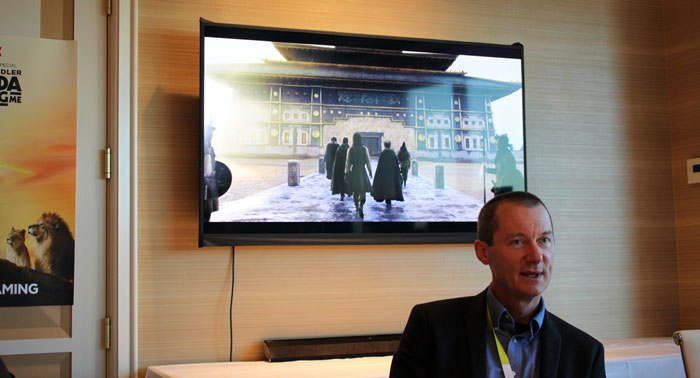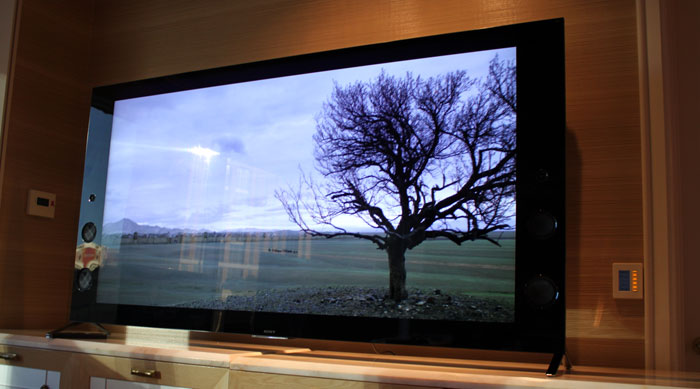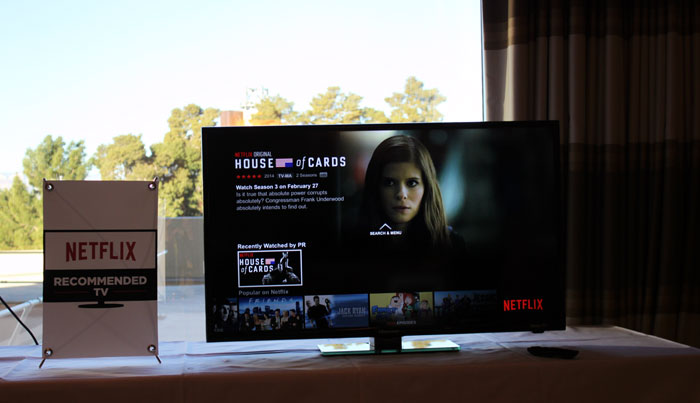We met Netflix at CES 2015 for a talk about 4K, HDR (high dynamic range), and future picture quality improvements. We also talked about Netflix’s new logo and the new user interfaces for Smart TV, iPad and the browser. Join us.
Picture quality in 2015 and onwards
This year, FlatpanelsHD met with three Netflix executives who are deeply involved in setting the course for the company; Neil Hunt (Chief Product Officer), Todd Yellin (Vice President of Product Innovation) and Cliff Edwards (Director of Corporate Communications and Technology). Netflix had not come to Las Vegas to talk about new TV series or movies, but to talk about the future of picture quality, and other new initiatives such as the "Recommended for Netflix" sticker.
Last year, Netflix started rolling out 4K streaming, and although the catalogue is still limited, the streaming service is showing the way. This year, Netflix will add another element with HDR (high dynamic range) that has the potential to take picture quality to new heights. HDR is not a fancy new buzzword, but an initiative that needs to be supported in every step of the chain from studios to TVs. HDR will make dark movie scenes appear deeper and richer, and make bright whites appear much brigther, for example a sun. We saw very compelling HDR demonstrations at CES, and it can have quite a dramatic and positive effect - if done correctly.

Netflix will start rolling out HDR content in 2015. It will be added as an extra layer on top of the 4K stream because HDR also requires a HDR-capable TV. So if your new 2015 TV supports HDR it will tell Netflix to stream the HDR 4K layer. If not, you will automatically receive the standard 4K layer.
Netflix is producing its own shows such as House of Cards and Marco Polo, and some of them are produced with HDR in mind. You can also expect to see HDR content from other studios on Netflix, too. There are ongoing talks with Sony, but nothing has been signed yet. Netflix also believes that a fairly large portion of studios’ back catalogues can be remastered in HDR.
To experience a HDR picture you need a TV with a much higher light output than a conventional screen, and the TV needs to be capable of controlling the higher light output in isolated areas. You will either need a LCD TV with LED zones (local dimming) that can control light output in a few hundred areas, or an OLED TV that can control it in every single pixel. Neil Hunt expects HDR 4K content to come in at around 18 Mb/s in bitrate (with HEVC), compared to 15.6 Mb/s for 4K. HDR in Full HD should be possible at below 10 Mb/s, but Netflix has not decided whether it wants to offer it in HD yet.

There are currently two HDR standards, namely Dolby Vision and the other standard that the UHD Alliance is defining. The difference is that Dolby Vision aims for around 4000 cd/m2 in the brightest areas and the other standard aims for around 1,000 cd/m2. Dolby Vision is therefore more expensive to implement in TVs, but Netflix assures us that it will support both standards - at least initially. FlatpanelsHD separately confirmed that LG, Samsung and Sony will support Netflix’s HDR streaming. The rest did not want to go on record yet.
HDR this year, wider color space and HFR later
So what comes after 4K and HDR? Neil Hunt explains that Netflix will later implement wider color gamuts. This is not a 2015 thing, so Netflix did not want to go into details, but it says that Rec.2020 is obviously a possibility down the line. HFR (high frame rate) is also in Netflix’s roadmap, but currently the catalogue is very limited. The three Hobbit movies were produced in 48fps HFR, and the three next Avatar movies will be produced in the same 48fps HFR, but that is about it. We guess we will hear more at next year’s CES.
But why then is Netflix in such as rush to support HDR when there is hardly a single HDR-capable TV out there? Netflix wants to show the world that streaming can be an engine for innovation. Netflix wants to be the innovator, not a follower. The video streaming architecture is much more flexible than for example cable TV, so Netflix can align new technologies to the TV manufacturers’ plans. Expect to see much more innovation from Netflix in the technical area in the coming years.
Neil Hunt's personal wish is that Netflix eventually starts streaming in 21:9, he says laughing.
New Smart TV user interface and more
Todd Yellin took over to talk about user experiences and interfaces. Netflix is currently seeing the largest increase in streaming activity from Smart TVs and tablets, so therefore it is focusing on improving the experience on these devices at the moment.
Within a few months or weeks, a new Smart TV user interface is expected to roll out. We had a chance to see it, but unfortunately no photos, so let us explain it instead. Netflix aims to make the experience smoother and as simple as possible, but also as visual as possible on the large screen. Yellin explains that one of the new elements of the user interface will be larger cover art for select “top picks” that Netflix recommends to you based on your viewing patterns.

The new interface also completely revamps the info page. When you click on a movie or TV show that you are considering, it will automatically start playing in the background with muted sound and a transparent menu overlay. Netflix has been testing the interface for a while and based on feedback from the testers it gives them a much sense of what the show is actually about, instead of reading text.
Netflix is also working on a new user interface for PC and iPad. It has only just begun experimenting with around 50-100,000 users, so it is too early to say whether it works. We briefly saw the new interface for PC (browsers) and Netflix has clearly tried to eliminate as many steps as possible. Instead of using the back button in your browser you now get an interface that expands and contracts. It looked great and it is certainly more visual.
For the iPad, Netflix is experimenting with "hierarchy" and larger graphics. When you scroll down through the list you will see "top picks" with larger covers, based on what Netflix thinks is a top pick for you. The hierarchical structure is made possible by the recommendations engine and a more flexible interface, says Yellin. Netflix is also considering highlighting movies and shows based on critical acclaim.
The new Smart TV interface will roll out later this year. If Netflix chooses to roll out the new PC and iPad interfaces it will happen sometime before summer.